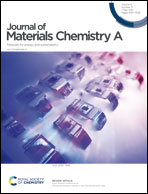Drastically increased electrical and thermal conductivities of Pt-infiltrated MXenes†
Abstract
MXenes have been reported to have excellent electrical and thermal properties theoretically. However, the actual properties of the synthesized MXene are far less than expected. This discrepancy arises mostly from the structural defects formed during synthesis. This work demonstrates that the thermal, electrical, and mechanical properties of the Ti3C2 MXene can be readily improved via the vapor phase infiltration (VPI) phenomenon of platinum (Pt) which usually occurs in the conventional atomic layer deposition (ALD) process. The infiltrated Pt atoms are found to cure Ti-defects in the MXene and to build bridges that interconnect MXene nanoflakes by creating covalent Pt–C bonds, which act as highly efficient channels for electrical and thermal conduction. The Pt infiltrated MXene displays drastic enhancement in thermal, electrical, and mechanical properties, simultaneously. Notably, both in-plane electrical/thermal conductivity and cross-plane electrical/thermal conductivity are found to significantly increase (∼2.4/∼1.8 times and ∼6.6/∼5.0 times, respectively). Electrothermal heaters made by using the Pt-infiltrated MXene exhibit outstanding efficiency, high heating rate, and good stability.



 Please wait while we load your content...
Please wait while we load your content...